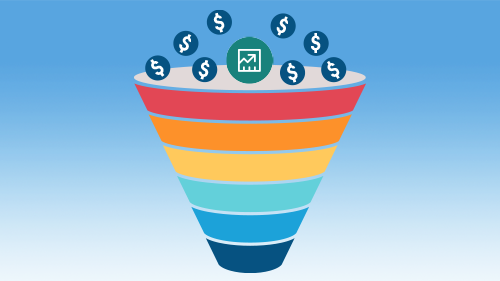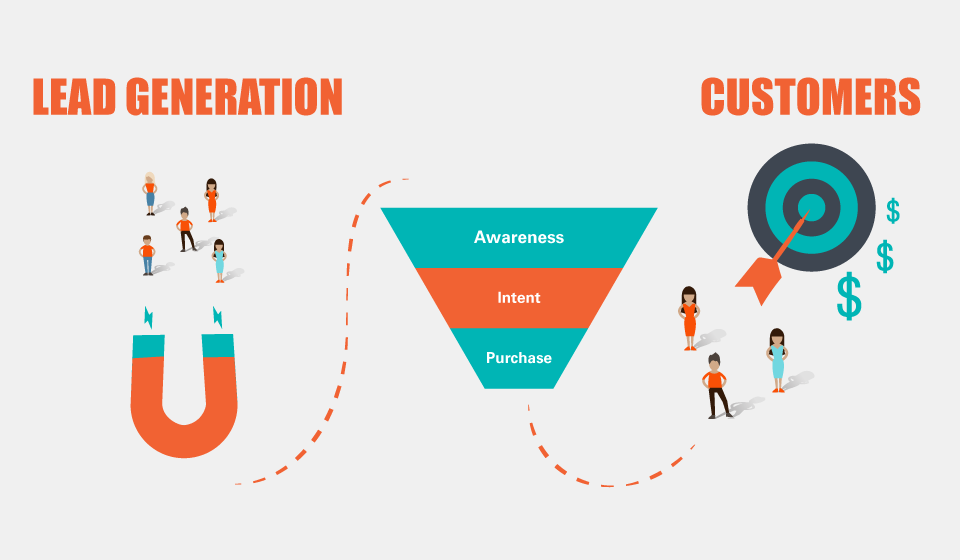Unlock powerful websites and sales funnels built to convert, with zero upfront costs. Let’s bring your vision to life and drive real results together.

Continuous sales success is crucial for the long-term growth and sustainability of any business.
This blog aims to shed light on the importance of continuous sales success and why investing in monthly sales funnels is worth it for founders.

One of the key reasons why continuous sales success is vital is because it ensures a steady stream of revenue for the business.
A monthly sales funnel allows founders to nurture leads and convert them into paying customers consistently.
By adopting a systematic approach to sales, founders can create a predictable revenue stream, which is crucial for strategic planning and growth.
Another benefit of continuous sales success is the ability to build strong relationships with customers. By constantly engaging with potential customers through each stage of the sales funnel, founders can develop a deeper understanding of their needs and preferences.
This enables them to tailor their offerings and provide personalized solutions, leading to higher customer satisfaction and loyalty.
Continuous sales success also allows founders to gather valuable data and insights. By analyzing the performance of each stage of the sales funnel, founders can identify areas of improvement and optimize their sales processes.
This data-driven approach helps to identify what works and what doesn’t, enabling founders to make informed decisions and allocate resources effectively.
Investing in monthly sales funnels is a worthwhile endeavor for founders. Unlike traditional sales methods that rely on sporadic efforts, monthly sales funnels provide a systematic and scalable approach to sales.
By implementing a structured sales system, founders can save time and effort, allowing them to focus on other critical aspects of the business.
Moreover, monthly sales funnels provide founders with a clear roadmap to follow. They outline the specific steps and actions needed to convert leads into customers, making the sales process more efficient and effective. This structured approach also allows founders to track progress, measure success, and adjust strategies accordingly.

Traditional sales strategies often fall short of achieving these goals, leading to frustration and stagnation. However, there is a powerful solution that founders can harness to unlock continuous sales success: monthly sales funnels.
Monthly sales funnels are a systematic approach to attract, engage, and convert potential customers into loyal buyers. Unlike one-time sales efforts, these funnels are designed for long-term success by nurturing leads and building relationships with customers throughout their buying journey.
One of the primary benefits of implementing monthly sales funnels is the ability to create a predictable revenue stream. By carefully mapping out each stage of the funnel, founders can forecast and anticipate sales conversions, enabling more accurate revenue projections.
This predictability empowers founders to make informed business decisions, allocate resources effectively, and plan for future growth.
Another advantage of monthly sales funnels is their ability to generate consistent leads. By utilizing various marketing strategies, such as content marketing, social media, and email marketing, founders can attract a steady flow of qualified leads into their funnel.
These leads can then be nurtured and guided through each stage of the funnel, increasing the likelihood of conversion.
Monthly sales funnels allow founders to build stronger customer relationships. By understanding their customers’ needs and pain points, founders can tailor their marketing messages and offers to provide personalized experiences.
This personalization not only increases customer satisfaction but also boosts customer loyalty and encourages repeat purchases.
Monthly sales funnels provide founders with valuable insights into their target audience and marketing strategies. Through analytics and data tracking, founders can identify which stages of the funnel are performing well and which need improvement.
This data-driven approach allows for continuous optimization and refinement of the funnel, resulting in higher conversion rates and increased sales.
Monthly sales funnels offer founders scalability and scalability. As the business grows, founders can easily replicate and scale their sales funnels across different products, markets, or customer segments.
This scalability enables founders to expand their reach and tap into new revenue streams without reinventing the wheel.

One such strategy that has gained significant traction is the implementation of monthly sales funnels. a comprehensive understanding of what monthly sales funnels are and why they are worth the investment for continuous sales success.
So, what exactly is a monthly sales funnel?
Simply put, it is a systematic approach to attracting, nurturing, and converting leads into paying customers every month.
Unlike traditional sales funnels that focus on one-time sales, monthly sales funnels are designed to create a recurring revenue stream by engaging customers in a continuous sales journey.
The core concept of a monthly sales funnel revolves around the idea of creating a predictable and scalable revenue model.
By implementing a strategic sequence of stages, such as lead generation, lead nurturing, and conversion, founders can guide potential customers through a well-defined sales process. This not only increases the likelihood of closing sales but also fosters long-term customer relationships and loyalty.
One of the key advantages of monthly sales funnels is the ability to generate consistent revenue month after month. Unlike sporadic sales efforts, a well-structured monthly sales funnel provides founders with a reliable income stream that can fuel business growth and sustainability.
Additionally, by focusing on customer retention and upselling, founders can maximize customer lifetime value and capitalize on the existing customer base.
Investing in monthly sales funnels also enables founders to gain valuable insights into customer behavior and preferences.
By analyzing data collected throughout the sales journey, founders can identify patterns, optimize their marketing and sales strategies, and make data-driven decisions.
This empowers founders to continuously refine their approach and adapt to changing market dynamics, ultimately boosting sales performance and overall business success.
In the fast-paced world of entrepreneurship, sales success is crucial for the survival and growth of any business.
As founders, we are constantly searching for new and innovative ways to secure customers and increase revenue. One such strategy that has been gaining momentum and proving to be immensely effective is the concept of monthly sales funnels.
Sales funnels have come a long way since their inception. Traditionally, the sales process involved a linear approach, where potential customers were guided through a series of steps, starting from awareness, moving on to interest, desire, and finally, action.
While this funnel model worked to some extent, it could not adapt to the changing needs and preferences of customers.
With the rise of digital marketing and the increasing reliance on data-driven insights, sales funnels have evolved into a more dynamic and customer-centric approach. The shift towards monthly sales funnels recognizes the need to engage customers consistently and build long-term relationships.
By breaking the traditional linear model, monthly sales funnels allow for ongoing communication and personalized interactions with potential customers, ultimately leading to higher conversion rates and customer loyalty.
The power of monthly sales funnels lies in their ability to nurture leads over time. By providing valuable content, personalized offers, and ongoing support, we can build trust and credibility with our audience.
This approach allows us to showcase the value of our products or services, address customer pain points, and demonstrate our expertise in the industry.
Additionally, monthly sales funnels enable founders to leverage automation and technology to streamline the sales process. Through the use of email marketing, social media campaigns, and targeted advertisements, we can reach a wider audience and generate more leads.
By analyzing data and tracking customer behavior, we can optimize our sales funnels, identify areas for improvement, and make data-driven decisions to boost our sales efforts.

As a founder, you play a pivotal role in the continuous sales success of your business.
we will explore why founders are essential to the implementation and maintenance of monthly sales funnels, and how they can unlock the power of this effective sales strategy.
Founders have a unique perspective and understanding of their business’s vision, goals, and target audience. This knowledge positions them as the driving force behind the development and execution of a successful monthly sales funnel.
By actively participating in the process, founders can ensure that the sales funnel aligns with their business objectives and effectively caters to their customer base.
One of the primary reasons founders are crucial to the continuous sales success of their business is their ability to provide strategic direction.
With their deep understanding of the market and industry trends, founders can guide their sales team in creating compelling offers, identifying the right target audience, and establishing a strong value proposition.
By actively participating in the sales process, founders can ensure that their vision and goals are effectively communicated throughout the funnel, resulting in increased conversions and long-term customer loyalty.
Founders serve as the ultimate brand ambassadors for their businesses. By actively engaging with potential customers, founders can establish personal connections, build trust, and effectively communicate the unique value their business offers.
This personal touch not only enhances the customer experience but also sets the foundation for building long-lasting relationships.
Founders also have a crucial role in monitoring and analyzing the performance of monthly sales funnels. By leveraging data and analytics, founders can identify areas of improvement, assess the effectiveness of different strategies, and make data-driven decisions.
By keeping a close eye on the sales funnel metrics, founders can optimize and refine the funnel continuously, ensuring maximum sales success.
Lastly, founders have the unique ability to inspire and motivate their sales team. By leading by example and sharing their passion and vision, founders can instill a sense of dedication and drive in their sales team. This motivation is essential in maintaining a high-performing sales funnel that consistently generates revenue.

One of the key elements to achieving continuous sales success is setting clear sales goals and objectives. As a founder, it is important to have a roadmap that guides your sales team towards achieving their targets and driving revenue growth.
In this blog, we will delve into the importance of setting clear sales goals and objectives and how they can unlock the power of monthly sales funnels.
Sales goals and objectives act as the foundation for your sales strategy. They provide a clear direction and purpose for your sales team, allowing them to align their efforts toward a common goal.
Without clear goals, your sales team may find themselves lost and unsure of what they are working towards. This can lead to a lack of motivation and decreased productivity.
When setting sales goals and objectives, it is crucial to make them specific, measurable, attainable, relevant, and time-bound (SMART). Particular goals provide clarity and help your team understand what is expected of them. Measurable goals allow you to track progress and determine whether you are on track to achieve your targets. Attainable goals ensure that your team is challenged but not overwhelmed. Relevant goals should align with your overall business objectives.
Lastly, time-bound goals provide a sense of urgency and enable you to monitor performance within a specific timeframe.
By setting clear sales goals and objectives, you can effectively measure the success of your monthly sales funnels. These goals act as benchmarks to track your team’s performance and ensure that they stay on track.
Regularly reviewing and adjusting your goals will help you stay agile and adapt to changing market conditions.
Moreover, clear goals and objectives facilitate effective communication and collaboration within your sales team. Everyone will be working towards a common objective, fostering a sense of unity and shared purpose.
This will also enable you to identify any gaps in skills or resources and address them proactively to ensure continuous sales success.

In the world of business, understanding your target audience is crucial for achieving continuous sales success. Without a clear understanding of who your customers are and what they want, your sales efforts can fall flat and your business may struggle to grow.
To begin, let’s define your target audience. This is the group of people who are most likely to be interested in your products or services.
By identifying and understanding this group, you can tailor your marketing messages, sales strategies, and product offerings to meet their specific needs and desires.
One effective way to identify your target audience is to conduct market research. This can include analyzing demographic data, conducting surveys or focus groups, and studying your competitors’ customer base.
By gathering this information, you can gain valuable insights into who your potential customers are, what motivates them to make a purchase, and where they can be reached.
Once you have a clear understanding of your target audience, it’s time to create ideal customer profiles. These profiles are fictional representations of your ideal customers and serve as a guide for your marketing and sales efforts.
By creating detailed profiles that include information such as age, gender, income level, interests, and pain points, you can better tailor your messaging and offers to resonate with these individuals.
But why should you invest time and effort into identifying your target audience and creating ideal customer profiles?

The answer lies in the power of monthly sales funnels. By understanding your audience and their needs, you can create a sales funnel that speaks directly to them, guiding them seamlessly from awareness to purchase and beyond.
This targeted approach increases the chances of converting leads into customers and nurturing long-term relationships.
Furthermore, by investing in monthly sales funnels that are tailored to your target audience, you can enjoy a higher return on investment. Rather than casting a wide net and hoping for the best, you can focus your resources on the individuals who are most likely to convert, maximizing your sales efforts and driving continuous success.

In the competitive business landscape, founders are constantly seeking ways to improve their sales performance and drive continuous sales success. One powerful tool that can greatly contribute to this goal is the implementation of monthly sales funnels.
As a founder, it is crucial to understand the importance of continuous sales success. While one-off sales may bring immediate revenue, the real value lies in establishing a consistent stream of sales that can sustain and grow your business over the long term. Monthly sales funnels provide a systematic approach to achieving this.
Monthly sales funnels offer several advantages over traditional sporadic sales efforts.
Firstly, they provide a predictable revenue stream that allows founders to plan and allocate resources effectively.
By analyzing and understanding the different stages of the sales funnel, founders can identify potential bottlenecks and optimize their strategies accordingly.
Monthly sales funnels enable founders to build strong relationships with customers. By engaging with potential leads at each stage of the funnel, founders can nurture these prospects, address their pain points, and build trust.
This leads to higher conversion rates and increased customer loyalty, resulting in long-term success.
![]()
To harness the power of monthly sales funnels, founders need to develop an effective sales strategy that aligns with their business goals and target audience.
Here are a few key steps to consider:
Identify your ideal customer profile and understand their needs, pain points, and buying behaviors. This will help you tailor your sales funnel to effectively address their specific requirements.
Divide your sales process into distinct stages, such as lead generation, lead nurturing, and conversion. This will provide a structured framework to guide your sales efforts and ensure a smooth flow of prospects through the funnel.
Utilize various marketing channels, such as content marketing, social media, and email campaigns, to attract potential leads and drive them into your sales funnel.
Develop personalized and targeted content to engage with your leads and address their specific pain points. Utilize automation tools to streamline the nurturing process and ensure consistent communication.
Continuously analyze and optimize your sales funnel by monitoring key metrics such as conversion rates, customer acquisition costs, and customer lifetime value. This will help you identify areas for improvement and drive ongoing sales success.

In today’s competitive business landscape, having a compelling value proposition is crucial for founders looking to achieve continuous sales success.
A value proposition is the unique combination of benefits and value that a product or service offers to its customers. It is what sets your business apart from competitors and convinces potential customers to choose your solution over others.
To develop a compelling value proposition, founders should start by understanding their target audience and the niche they operate in. This involves conducting market research and identifying the pain points and needs of their potential customers.

By understanding what drives their target audience and what they are looking for in a solution, founders can tailor their value proposition to address these specific needs.
Once the target audience’s needs are identified, founders should focus on communicating the unique benefits their product or service offers.
This includes highlighting the features that differentiate their solution from competitors and how these features directly address the pain points of their target audience. It is essential to clearly articulate the value that customers will receive by choosing your product or service.
A compelling value proposition should also be concise and easy to understand. Founders should avoid using jargon or technical language that may confuse or alienate potential customers.
Instead, they should use simple language that can resonate with the target audience. The value proposition should be easily communicated in a few sentences, making it memorable and shareable.
Furthermore, founders should continuously refine and evolve their value proposition as their business grows and the market changes. This requires staying updated with industry trends, customer feedback, and competitive analysis.
By constantly monitoring the market and making necessary adjustments, founders can ensure that their value proposition remains relevant and compelling.

In the world of sales, success is not measured by random achievements or sporadic bursts of activity. True success is achieved through consistent efforts and a systematic approach.
To ensure continuous sales success, founders must establish key performance indicators (KPIs) that act as guiding metrics for their sales team.
KPIs are quantifiable measures that help track progress towards specific goals. By setting KPIs, founders can align their sales team’s efforts with the overall sales objectives of the company.
These indicators provide clear benchmarks against which performance can be evaluated, allowing for data-driven decision-making and continuous improvement.
When it comes to continuous sales success, monthly sales funnels are worth the investment. Unlike traditional approaches that focus on closing deals as quickly as possible, monthly sales funnels provide a systematic and sustainable approach to sales.
They break down the sales process into distinct stages, allowing founders to identify areas of strength and weakness. With a monthly sales funnel in place, founders can track the progress of potential customers at each stage and make informed decisions to optimize the conversion rates.
To establish effective KPIs for sales success, founders must first identify the key stages of their monthly sales funnel. These stages typically include lead generation, lead qualification, proposal/presentation, negotiation, and closing.
For each stage, specific KPIs can be set to measure the team’s performance. Some common KPIs include the number of leads generated, conversion rates, average deal size, and sales cycle length.
It is important to note that KPIs should be aligned with the overall sales goals and be realistic and achievable.
They should also be regularly reviewed and adjusted based on changing market dynamics and business objectives. By regularly tracking and analyzing these KPIs, founders can identify areas for improvement and take proactive measures to enhance the sales process.

In today’s ever-evolving business landscape, founders face numerous challenges when it comes to achieving continuous sales success. The traditional approach of sporadic sales efforts and one-time deals is no longer sufficient.
To thrive in the competitive market, founders need to adopt a more strategic and systematic approach to sales – one that revolves around the concept of monthly sales funnels.
By delving into the intricacies of this framework, founders can unlock the power of continuous sales success and establish a sustainable revenue stream for their businesses.
A sales funnel is a visual representation of the customer journey, from the initial contact to the final purchase. It is divided into several stages, each representing a specific phase in the buying process.
By understanding the sales funnel framework, founders can effectively guide their prospects through each stage, ultimately converting them into paying customers.

One of the key advantages of monthly sales funnels is their ability to create predictable revenue streams. Unlike traditional sales methods that rely on sporadic deals, monthly sales funnels provide founders with a systematic approach to generating consistent sales.
By breaking down the customer journey into monthly stages, founders can streamline their sales efforts and optimize their conversion rates.
Furthermore, monthly sales funnels allow founders to build stronger relationships with their customers. By nurturing prospects through the different stages of the funnel, founders can establish trust and credibility, increasing the likelihood of repeat business and referrals.
This customer-centric approach not only enhances the overall customer experience but also maximizes customer lifetime value.
Implementing monthly sales funnels also offers founders valuable insights into their sales process. By tracking key metrics at each stage of the funnel, founders can identify areas for improvement, optimize their sales strategies, and make data-driven decisions.
This iterative approach enables continuous sales success by constantly refining and adapting the sales funnel to meet changing customer needs and market conditions.
![]()
Understanding the buyer’s journey is essential for founders seeking continuous sales success. In today’s ever-evolving marketplace, it is crucial to unlock the power of monthly sales funnels and leverage them effectively to drive revenue growth.
The buyer’s journey refers to the process that potential customers go through from the moment they become aware of a problem or need to the point where they make a purchase decision.
By mapping this journey, founders gain valuable insights into the various touchpoints and interactions that influence a buyer’s decision-making process.
Mapping the buyer’s journey starts with identifying the different stages a prospect goes through. These stages typically include
During the awareness stage, the buyer becomes aware of their problem or need and begins researching potential solutions.
In the consideration stage, they evaluate different options and compare alternatives. Finally, in the decision stage, the buyer makes a purchase decision based on their evaluation.
Understanding the buyer’s mindset and emotions at each stage of the journey is crucial. By recognizing their pain points, desires, and motivations, founders can tailor their marketing and sales strategies accordingly.
This allows them to provide the right information and support to potential customers at each stage, nurturing them towards making a purchase.
Effective mapping of the buyer’s journey also involves identifying the various touchpoints where the buyer interacts with the brand.
These touchpoints can include website visits, social media engagement, email interactions, and customer reviews.
By analyzing these touchpoints, founders can optimize their sales funnels to provide a seamless and personalized experience for potential customers.
Furthermore, mapping the buyer’s journey helps identify potential roadblocks or gaps in the sales process.
By understanding where prospects might drop off or lose interest, founders can make informed decisions about optimizing their sales funnels and enhancing customer engagement.

In the fast-paced world of business, founders are constantly on the lookout for effective strategies to drive sales and keep their companies thriving. One such strategy that has gained significant traction in recent years is the concept of monthly sales funnels.
Lead generation is the lifeblood of any business. Without a steady stream of potential customers, it becomes increasingly difficult to sustain growth and profitability.
This is where engaging lead-generation strategies come into play. By crafting strategies that captivate and entice your target audience, you can ensure a consistent flow of qualified leads into your sales funnel.
One crucial aspect of crafting engaging lead-generation strategies is understanding your target audience.
By conducting thorough market research and customer profiling, founders can gain valuable insights into the needs, preferences, and pain points of their potential customers. Armed with this information, you can tailor your lead generation strategies to resonate with your target audience, making your efforts more impactful and effective.
Another key element of engaging lead-generation strategies is creating compelling content. Whether it’s blog posts, social media campaigns, or videos, the content you produce should be informative, relevant, and valuable to your audience.
By offering valuable insights and solutions to their problems, you can establish yourself as an authority in your industry and build trust with your potential customers.
Additionally, founders should leverage various channels to reach their target audience. From social media platforms to email marketing campaigns, it’s important to diversify your lead generation efforts.
This multi-channel approach ensures that you reach a wider audience and increases the chances of capturing leads from different sources.
Furthermore, founders must continuously evaluate and optimize their lead-generation strategies. By monitoring key performance indicators and analyzing data, you can identify what works and what doesn’t. This allows you to make data-driven decisions and refine your strategies for maximum effectiveness.
In the world of sales, nurturing and qualifying leads is an essential step towards achieving continuous sales success. As a founder, it is crucial to understand the importance of this process and how it can unlock the power of monthly sales funnels.
Nurturing leads refers to the process of building relationships with potential customers, even before they are ready to make a purchase.
This involves engaging with prospects through various channels such as email marketing, social media, and content creation.
By providing valuable and relevant information to these leads, you can establish trust and credibility, making them more likely to choose your product or service when the time comes.
Qualifying leads, on the other hand, involves determining the readiness and suitability of potential customers to make a purchase.
By asking the right questions and conducting thorough research, you can identify whether a lead has the budget, authority, need, and timeline (BANT) to become a qualified prospect.
This process helps you prioritize your efforts and focus on leads that have a higher likelihood of converting into paying customers.
One of the key benefits of nurturing and qualifying leads is that it allows you to build a pipeline of potential customers who are interested in your product or service.
This pipeline acts as the foundation of a monthly sales funnel, ensuring a steady stream of qualified leads that are ready for the next stage in the sales process.
Moreover, nurturing and qualifying leads can also help you understand your target audience better. By engaging with leads and gathering insights about their pain points, preferences, and motivations, you can refine your sales messaging and tailor your offerings to meet their specific needs. This knowledge can give you a competitive edge and improve your conversion rates.
To effectively nurture and qualify leads, it is essential to employ a systematic approach. This involves implementing marketing automation tools to streamline your communications, tracking and analyzing data to measure the success of your efforts, and continuously optimizing your strategies based on the insights gained.

In the world of sales, leads are the lifeblood of any business. They represent potential customers who have shown interest in your product or service. However, the real challenge lies in converting those leads into paying customers.
The first step in converting leads is to understand your target audience. By knowing their pain points, desires, and motivations, you can tailor your sales messages to resonate with them.
Conduct thorough market research and analyze customer data to gain insights into their needs and preferences. This will enable you to create compelling sales pitches that address their specific challenges and provide solutions.
Next, establish a strong sales funnel. A sales funnel is a step-by-step process that guides leads toward making a purchase.
It typically consists of awareness, interest, decision, and action stages. By strategically nurturing leads at each stage, you can increase the likelihood of conversion. Utilize various marketing channels such as social media, email marketing, and content marketing to engage with leads and move them through the sales funnel.
Personalization is key when converting leads into paying customers. Tailor your communication and offers to meet each lead’s individual needs.
Use automation tools to segment your leads based on demographics, behaviors, and interests. This will allow you to send targeted messages that resonate with each lead, increasing the chances of conversion.
Building trust is crucial in the conversion process. Provide social proof by showcasing testimonials, case studies, and customer success stories.
Offer free trials or demos to let leads experience the value of your product firsthand. Use persuasive language and clear calls to action to guide leads toward taking the next step.
Additionally, timely follow-ups are essential for conversion success.
Implement a robust lead nurturing system that includes regular communication, personalized offers, and reminders.
Be responsive to inquiries and address any concerns promptly. By staying top-of-mind and demonstrating your commitment to customer satisfaction, you can convert leads into paying customers.

In today’s competitive business landscape, founders need to adopt innovative strategies to stay ahead of the game. One such strategy is implementing a monthly sales funnel, which has proven to be a game-changer for countless successful companies.
To begin with, let’s understand what a sales funnel is. A sales funnel is a visual representation of the customer journey, from the initial contact to the final purchase. It is divided into different stages, including awareness, interest, consideration, and conversion.
By mapping out this process, founders can efficiently guide potential customers through each stage, increasing the likelihood of conversion.
To set up the sales funnel infrastructure, founders must start by clearly defining their target audience. By understanding their customers’ pain points, desires, and preferences, they can tailor their marketing messages and content to resonate with their audience effectively. This step is crucial in attracting the right prospects and ensuring a high conversion rate.
Next, founders need to create compelling content at each stage of the sales funnel. From blog posts and social media updates to videos and webinars, the content should be engaging and informative, providing value to the audience.
By consistently delivering valuable content, founders can build trust and establish themselves as industry experts, ultimately driving more sales.
Another essential aspect of the sales funnel infrastructure is lead generation. Founders can utilize various strategies, such as search engine optimization (SEO), social media advertising, and email marketing, to attract potential customers and capture their contact information.
This enables founders to nurture leads and guide them through the sales funnel effectively.
Furthermore, founders should leverage marketing automation tools to streamline their sales funnel operations.
These tools allow for personalized communication, automated lead nurturing, and data analysis, saving time and effort while maximizing results. By automating repetitive tasks, founders can focus on building relationships and closing deals.
Now, why are monthly sales funnels worth the investment?
Monthly sales funnels provide a predictable flow of leads and sales, ensuring consistent revenue growth. Unlike traditional sales methods that rely on sporadic efforts, monthly sales funnels create a systematic approach that generates continuous results.
This sustainability is particularly valuable for founders looking to scale their businesses and maintain a competitive edge.

In today’s fast-paced digital world, leveraging technology and automation tools is essential for founders looking to achieve continuous sales success.
With the rise of monthly sales funnels as a proven method for generating consistent revenue, it becomes even more crucial to harness the power of technology to streamline and optimize your sales processes.
One of the key advantages of using technology in your sales funnel is the ability to automate repetitive tasks. By automating time-consuming activities such as lead generation, nurturing, and follow-ups, you can free up your team’s time to focus on high-value tasks that require human touch.
Automation tools like customer relationship management (CRM) systems, email marketing platforms, and chatbots can help you automate these processes seamlessly, ensuring that no leads slip through the cracks and that every prospect receives the attention they deserve.
Furthermore, leveraging technology allows you to gather valuable data and insights about your customers and their buying behavior. By integrating analytics tools into your sales funnel, you can track and measure various metrics, such as conversion rates, customer lifetime value, and sales attribution.
These insights enable you to make data-driven decisions, optimize your sales funnel, and identify areas where improvements can be made.
Technology also enables founders to provide a personalized and seamless buying experience for their customers. With the help of customer analytics and automation tools, you can segment your audience based on their preferences, behavior, and demographics, allowing you to tailor your messaging and offers to each individual.

This level of personalization not only enhances customer satisfaction but also increases the likelihood of conversions and repeat business.
Additionally, technology can empower your sales team by providing them with the right tools and resources to sell more effectively.
From sales enablement platforms that centralize content and collateral, to virtual meeting software that facilitates remote sales presentations, there is a multitude of tools available to support your team’s efforts.
By equipping your team with the right technology, you enable them to engage with prospects and close deals more efficiently, ultimately driving continuous sales success.
By automating repetitive tasks, gathering valuable data, providing personalized experiences, and empowering your sales team, technology can significantly enhance your sales processes and drive revenue growth.
Embracing technology not only saves time and resources but also allows you to stay ahead of the competition in today’s rapidly evolving business landscape.

In today’s highly competitive business landscape, it is crucial for founders to continuously monitor and analyze sales metrics to drive continuous sales success.
Sales metrics provide valuable insights into the performance of your sales team and the overall health of your business.
By understanding and analyzing these metrics, founders can make informed decisions, identify areas of improvement, and optimize their sales processes.
One of the key benefits of tracking sales metrics is the ability to measure and evaluate the effectiveness of your sales funnels.
By monitoring metrics such as conversion rates, customer acquisition costs, and average deal size, founders can gain a deeper understanding of their sales funnel’s performance. This enables them to identify bottlenecks and areas of improvement, allowing for more effective sales strategies and increased revenue generation.
Another crucial aspect of tracking sales metrics is the ability to identify and analyze sales trends over time.
By monitoring metrics such as monthly sales growth, customer churn rate, and sales cycle length, founders can gain valuable insights into the overall health and growth trajectory of their business. This allows for proactive decision-making and the ability to adapt and adjust sales strategies to maximize sales success.
Furthermore, tracking and analyzing sales metrics can provide founders with a clearer understanding of customer behavior and preferences.
By monitoring metrics such as customer lifetime value, customer satisfaction scores, and customer retention rates, founders can identify their most valuable customers and tailor their sales efforts accordingly. This not only improves customer satisfaction but also boosts customer loyalty and drives repeat business.
In conclusion, tracking and analyzing sales metrics is an essential practice for founders looking to achieve continuous sales success.
By understanding the performance of their sales funnels, identifying trends, and gaining insights into customer behavior, founders can make data-driven decisions that optimize their sales processes and drive revenue growth. Embracing the power of monthly sales funnels and leveraging the insights provided by sales metrics will give founders a competitive edge in today’s dynamic business environment.

In today’s competitive business landscape, founders are constantly seeking ways to improve their sales performance and generate higher conversion rates. The key to achieving continuous sales success lies in unlocking the power of monthly sales funnels.
By understanding why monthly sales funnels are worth the investment, founders can optimize their conversion rates and ultimately drive more revenue.
A monthly sales funnel is a strategic approach to sales that involves breaking down the customer journey into stages, from awareness to purchase.
By implementing a systematic process, founders can guide potential customers through each stage, increasing the likelihood of conversion.
This approach offers several advantages over traditional sales methods.
Firstly, monthly sales funnels provide founders with a clear understanding of their customer’s needs and preferences at each stage of the sales process.
By segmenting their target audience and tailoring their messaging accordingly, founders can speak directly to their customers’ pain points, building trust and credibility.
This personalized approach significantly improves conversion rates, as customers feel understood and are more likely to make a purchase.
Additionally, monthly sales funnels enable founders to track and analyze key performance metrics at every stage. By utilizing analytics tools and data-driven insights, founders can identify bottlenecks in the sales process and make necessary adjustments.
This iterative approach allows for continuous optimization, resulting in improved conversion rates over time.
Another benefit of monthly sales funnels is the ability to nurture leads and build relationships with potential customers.
By implementing email marketing campaigns, founders can stay top-of-mind with their audience, providing valuable content and offers. This consistent engagement fosters trust and loyalty, increasing the likelihood of conversion and repeat business.
Furthermore, monthly sales funnels provide founders with a predictable revenue stream. By focusing on building long-term relationships with customers, rather than solely on one-time sales, founders can create a sustainable business model.
This recurring revenue model not only stabilizes cash flow but also allows for better planning and resource allocation.
In the fast-paced world of sales, it is no longer enough to simply create a sales funnel and let it run on autopilot. To stay ahead of the competition and ensure continuous sales success, founders must embrace the idea of continuously improving and iterating their sales funnels.
Sales funnels are the backbone of any successful business, guiding potential customers through every stage of the buying journey. However, today’s market demands constant adaptation and optimization.
Continuous improvement allows founders to identify and address bottlenecks, improve conversion rates, and maximize revenue.
By embracing a mindset of continuous improvement, founders can stay agile and responsive to ever-changing customer needs.
The Power of Iteration:
Iteration is the key to unlocking the full potential of your sales funnels. It involves making small, incremental changes based on data-driven insights to drive better results.
By testing and tweaking various elements within the sales funnel
– from landing pages to email copy and follow-up sequences
– founders can optimize the customer journey, boost conversions, and ultimately drive more sales.
Remember, even small tweaks can have a significant impact on your bottom line.
Founders must analyze key metrics such as conversion rates, bounce rates, and customer feedback to identify areas for improvement. Tracking and analyzing data allows you to make informed decisions and prioritize areas that need attention.
By running A/B tests on different elements of your sales funnel, you can determine which variations perform better. Test different headlines, calls-to-action, or pricing models to find the winning combination that resonates most with your target audience.
Actively seek feedback from your customers to gain valuable insights into their pain points, preferences, and expectations. This information can guide improvements and help you create a more customer-centric sales funnel.
Leverage automation tools and personalization techniques to deliver tailored experiences to your customers. Automating repetitive tasks and personalizing messages can enhance engagement and build stronger relationships with your audience.